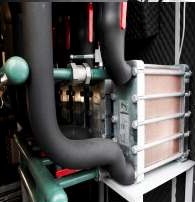UK supermarket cuts carbon footprint through innovative technology
Supermarket chain Sainsbury has managed to heavily reduce the carbon footprint of a heating and cooling installation at its 9,300 square meter supermarket in Crayford, Kent, in the UK. This has been done by using innovative technologies combined with an intelligent energy management system.

Elimination of gas as an energy source
The two key pioneering technologies used at the Crayford supermarket are geoscart geo-exchange and CO2 transcritical booster refrigeration systems. These two advanced solutions – combined with an intelligent energy management system – have resulted in the elimination of gas as an energy source. The overall total store energy consumption is also expected to be reduced by at least 30 percent.
Geoscart geo-exchange and CO2 transcritical booster refrigeration enable both heating and cooling to be produced simultaneously from renewable sources. It is the first time this has been accomplished. These two solutions jointly also means the debut of a closed loop borehole system integrated with CO2 refrigeration (read more in facts box). The boreholes form part of the proprietary geoscart thermal energy management system.
Dmitriy Zaynulin, Chief Technology Officer for geoscart, is excited to work with Sainsbury’s, and their partners, on this important project. According to him, the store’s revolutionary integrated design allows effective thermal energy management between refrigeration, heating, and also central control and storage systems. The technical challenge is highlighted by the total capacity of the integrated systems exceeding 2MW thermal, and covering a wide range of loads from -34 °C (low temperature refrigeration) to 70 °C (domestic hot water services).
Thermal energy reused
“All thermal energy is beneficially reused by storing excess seasonal heating, or cooling energy for the following season, making it a very efficient and sustainable system,” Zaynulin says.
“Careful attention was given when selecting all components. For example, maximizing the efficiency of the integrated system for Sainsbury’s depended on a very close temperature approach in the heat exchangers together with linked load parameters. Similarly, the overall success of this project depended on a very close cooperative approach in all parties working together.” The transcritical CO2 refrigeration pack has been supplied by SCM FRIGO. “This project is a big step forward towards the integration of refrigerating and heating systems, with renewable energy sources,” says Mirko Bernabei, Technical Director at SCM FRIGO. “Integrated design and integrated energy management create a synergy that gives great results in terms of efficiency and of carbon footprint reduction. Being part of such a cutting-edge project makes us proud, because this witnesses the great results achieved from our company during the past years in the development of new environmental friendly products.”
The transcritical CO2 refrigeration pack has been supplied by SCM FRIGO. “This project is a big step forward towards the integration of refrigerating and heating systems, with renewable energy sources,” says Mirko Bernabei, Technical Director at SCM FRIGO. “Integrated design and integrated energy management create a synergy that gives great results in terms of efficiency and of carbon footprint reduction. Being part of such a cutting-edge project makes us proud, because this witnesses the great results achieved from our company during the past years in the development of new environmental friendly products.”
SWEP has provided brazed plate heat exchangers for both the supermarket refrigeration pack and the heat pumps for heating.
Innovative project
“We are very happy to be part of this innovative project. In the summer, the store is cooled with cold ground water, while in the winter, the same ground water is used for heating,” says Stefano Bellada, Application Manager at SWEP. “This way, all available energy is reused, making it a very efficient and sustainable system. Careful attention was given when selecting the brazed plate heat exchangers, because it is necessary to use a very close temperature approach. The heat exchangers were chosen for the purpose of maximizing system efficiency at Sainsbury’s”.
FACTS
Geoscart geo-exchange and CO2 transcritical booster refrigeration
Geoscart technology known as geo-exchange uses a series of closed loop boreholes drilled to 200 metres underground to access the natural geothermal potential within the Earth. The boreholes deliver geothermal temperature-conditioned cooling fluid to the refrigeration packs. This enables the system to capture and store the waste heat, which is later released to provide heating and hot water in the store via heat pumps.
A transcritical CO2 booster is a refrigeration system that covers both medium-term and long-term demands of small- to large-size supermarkets. This technology combines the advantages of natural refrigerant with that of achieving higher efficiencies than systems using HFC refrigerants. The water-based borehole cooling further enhances these efficiencies, and greatly assists in optimizing CO2 refrigeration system performance.

